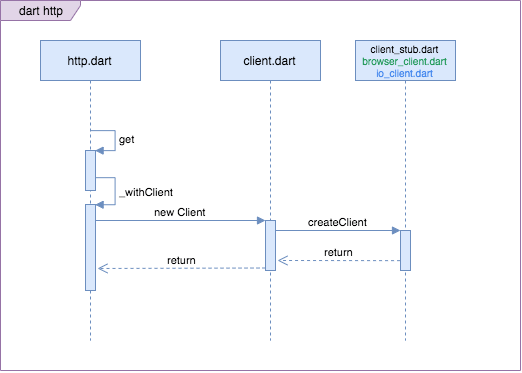Flutter多平台适配机制就是这么简单
2019-12-18 小文字
我们都知道到Flutter在表现层做到了多端一致性,通过Android、iOS各自平台下的渲染实现了一致的UI效果。 那么如果你只是要开发一个适配Android, iOS, Web的三方库,有什么好的简单思路?
Flutter网络请求
在开发Flutter的时候可以使用http核心库。也可以使用社区的其他封装类库,比如dio。两者的底层实现都是http_parser
如果开发者不小心在flutter中直接使用了平台相关的类库,则会导致扩平台运行出错,比如使用io包下的http在浏览器下执行肯定会报错。
http核心库已经为我们做好了平台适配,下面看一下他是怎么做的适配:
import 'package:flutter/cupertino.dart';
import 'package:http/http.dart' as http;
void hello(){
print('a.dart => hello');
http.get('http://127.0.0.1:8080').then((response){
debugPrint('response => ${response.statusCode} ${response.body}');
});
}
这段代码可以跑在移动设备,也可以跑在浏览器设备,得到一致的输出效果。
http核心库
现在我们以get请求为例,看一下他的内部逻辑:
 在http接口类中,最终会执行
在http接口类中,最终会执行_withClient来选用Client的实现类,类似静态代理效果。
具体来说,在编译为web使用时,最终导包使用的是src/browser_client.dart, 其底层实现是,dart:html下的HttpRequest, 最终用的是前端的ajax技术:XMLHttpRequests。
/// Used from conditional imports, matches the definition in `client_stub.dart`.
BaseClient createClient() => BrowserClient();
/// A `dart:html`-based HTTP client that runs in the browser and is backed by
/// XMLHttpRequests.
///
/// This client inherits some of the limitations of XMLHttpRequest. It ignores
/// the [BaseRequest.contentLength], [BaseRequest.persistentConnection],
/// [BaseRequest.followRedirects], and [BaseRequest.maxRedirects] fields. It is
/// also unable to stream requests or responses; a request will only be sent and
/// a response will only be returned once all the data is available.
class BrowserClient extends BaseClient
针对非浏览器使用的是io类库,src/io_client.dart, 其底层实现是dart:io下的HttpClient
/// Used from conditional imports, matches the definition in `client_stub.dart`.
BaseClient createClient() => IOClient();
/// A `dart:io`-based HTTP client.
///
/// This is the default client when running on the command line.
class IOClient extends BaseClient
条件导包
这里有个比较有意思的语法:
http核心库是如何做到的的平台差异?
通过观察src/client.dart的导包情况,可以看到如下代码:
// ignore: uri_does_not_exist
import 'client_stub.dart'
// ignore: uri_does_not_exist
if (dart.library.html) 'browser_client.dart'
// ignore: uri_does_not_exist
if (dart.library.io) 'io_client.dart';
这里实际上使用的dart中的特殊语法:条件导包。 相关详情可以查阅dart文档。
简单来说就是利用有条件的import/export,在编译期间,差异化导包,从而可以实现平台适配。
使用条件导包的具体做法如下:
- 首先定义一个接口,用于多端实现;
- 接口类中利用import/export按需导入,导出对应的实现类库
export 'src/hw_none.dart' // Stub implementation
if (dart.library.io) 'src/hw_io.dart' // dart:io implementation
if (dart.library.html) 'src/hw_html.dart'; // dart:html implementation
运用场景
利用该机制可以方便的进行多平台适配。类似的dio也有一段导包差异逻辑src/dio.dart。
import 'entry_stub.dart'
// ignore: uri_does_not_exist
if (dart.library.html) 'entry/dio_for_browser.dart'
// ignore: uri_does_not_exist
if (dart.library.io) 'entry/dio_for_native.dart';
顺便看下dio和http的依赖情况。dio是一个http上传的封装库,提供了较多便捷的api,当然相对的也带了学习成本,具体是否采用就看项目的实际需要。
|-- dio 3.0.7
| |-- http_parser 3.1.3
| | |-- charcode...
| | |-- collection...
| | |-- source_span...
| | |-- string_scanner...
| | '-- typed_data...
| '-- path...
|-- http 0.12.0+2
| |-- async...
| |-- http_parser...
| |-- path...
| '-- pedantic...
参考
- https://dart.dev/guides/libraries/create-library-packages#conditionally-importing-and-exporting-library-files
- https://pub.dev/packages/http_parser
- https://pub.dev/packages/http